How to make a porgy rig
Ever tried catching porgy? If not, you’re missing out on some serious fun. These little guys are all over coastal waters and can really put up a fight. Whether you’re a newbie or a seasoned angler, porgy fishing offers a great way to spend a day on the water. Plus, they’re tasty! But before you head out, you gotta have the right gear and know-how. From rods and reels to the perfect bait, this guide covers everything you need to know about porgy rigs and more. Get ready to reel in some porgies!
Key Takeaways
- Choosing the right gear is crucial for porgy fishing success.
- Porgy rigs and dropper loops increase your catch rate.
- Natural baits like clams and squid work best for porgies.
- Try bottom fishing, chumming, and jigging to attract porgies.
- Fishing in different waters requires adapting your techniques.
Choosing the Right Gear for Porgy Fishing
Rods and Reels for Porgy Fishing
When it comes to porgy fishing, picking the right rod and reel combo can make all the difference. Light to medium-light rods, typically around 6 to 7 feet long, work wonders. They give you the sensitivity needed to feel those subtle bites, which is crucial because porgies can be sneaky. Pair your rod with a spinning reel in the 2500-4000 size range. This setup is balanced and versatile, ideal for handling the unexpected fight of a larger porgy. Look for rods made from graphite as they offer great sensitivity and are lightweight, which is perfect for a long day on the water.
Line and Leaders for Porgy Rigs
Your choice of line can impact your fishing success. Braided line in the 10-20 pound test range is a great pick for porgy fishing, and pairing it with the right leader material can make a significant difference. It’s thin, so you get more line on your reel, and it’s super sensitive, which helps in feeling those light bites. Connect this to a fluorocarbon leader of about 15-20 pounds. Fluorocarbon is almost invisible underwater, which is a big plus when fishing in clear waters. If you’re fishing in areas with less visibility or wary fish, a monofilament line might be a better choice, as it provides a good balance of strength and stealth.
Hooks and Rigs for Porgy Fishing
Small porgy hooks are key when targeting porgies due to their small mouths. Sizes 1 to 2/0 are typically effective. Circle hooks are popular since they often hook the fish in the corner of the mouth, making catch and release easier. A hi-low rig is a favorite among porgy anglers, allowing you to present at least two hooks with different baits at once. This rig lets you present two baits at once, increasing your chances of a bite. However, using multiple hooks can increase the risk of rig tangling, so it’s important to manage your setup carefully. Consider adding small, colorful beads or spinners above the hooks to attract fish, especially in murky waters. These rigs can be pre-tied or made on the spot with basic tackle, making them convenient for any fishing trip.
Porgy Rigs and Dropper Loops
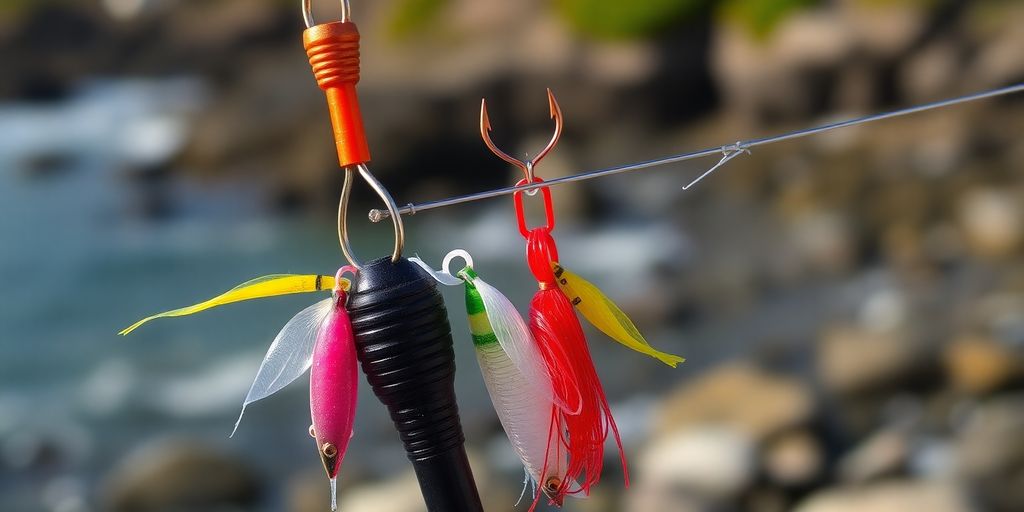
Understanding Porgy Rigs
When it comes to catching porgy, the setup of your rig can make a huge difference. Porgy rigs are often designed to handle the rocky bottoms where these fish are found. A common choice is the hi-low rig, which lets you present two baits at different depths on the main line. This increases your chances of hooking a fish by covering more of the water column. Adding small, colorful beads or spinners above the hooks can help attract porgies, especially in murky waters.
How to Set Up a Dropper Loop
Setting up a dropper loop is a handy skill for any angler targeting porgies. Here’s a simple way to do it:
- Cut a length of line longer than you need.
- Form a loop in the line and twist it several times.
- Pass the loop through the center of the twists.
- Pull both ends of the line to tighten the loop.
Once you’ve got your dropper loop set up, you can attach hooks or weights to suit your fishing needs. This rig is great for keeping bait off the bottom and in the strike zone.
Benefits of Using Dropper Loops
Using dropper loops in your porgy rigs offers several advantages:
- Versatility: Allows for multiple hooks or baits at varying depths.
- Efficiency: Keeps bait in the strike zone, increasing your chances of a catch.
- Easy to tie and adjust, making it a favorite among anglers.
Dropper loops are a fantastic addition to your tackle box. They’re simple to create yet incredibly effective, especially when you’re out on the water trying to land that perfect porgy.
Bait and Hooks for Porgy Fishing
Natural Baits for Porgy Fishing
When it comes to porgy fishing, natural baits are often the go-to choice. These fish are particularly fond of mollusks, clams, squid strips, and soft baits like sandworms. Each angler has their favorite, and sometimes even a secret bait, but these basics are a great starting point. Squid, for instance, is a popular pick because it stays on the hook well, even when smaller fish are nibbling away. Sandworms are also a top choice, especially if you’re targeting larger porgies.
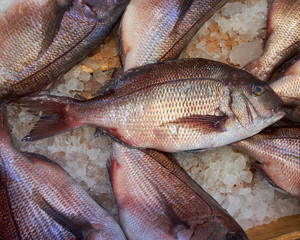
Artificial Lures for Porgy
If you’re looking to switch things up, artificial lures can also be quite effective. Small bucktail jigs or soft plastics in natural colors often do the trick. The key is to mimic the movement of natural prey, so think about how a small fish or shrimp might dart through the water. Jig heads with soft plastics or small spinners can also work wonders, especially in offshore settings where porgies might be a bit more aggressive.
Choosing the Right Hook Size
Selecting the right hook size is crucial for successful porgy fishing. These fish have relatively small mouths, so you’ll want to go with smaller hooks—typically size 1 to 2/0. Circle hooks are particularly effective because they tend to catch the fish in the corner of the mouth, making it easier to release them if needed. The hi-low rig is a popular choice, featuring two hooks above a sinker, allowing you to present multiple baits at once. Adding small colored beads or spinners can also help attract porgies, especially in murky waters.
Remember, porgies are opportunistic feeders, so experimenting with different baits and setups can lead to a more successful fishing trip. Keep your bait small and varied to match their feeding habits, and you’ll likely see better results.
Porgy Fishing Techniques and Strategies
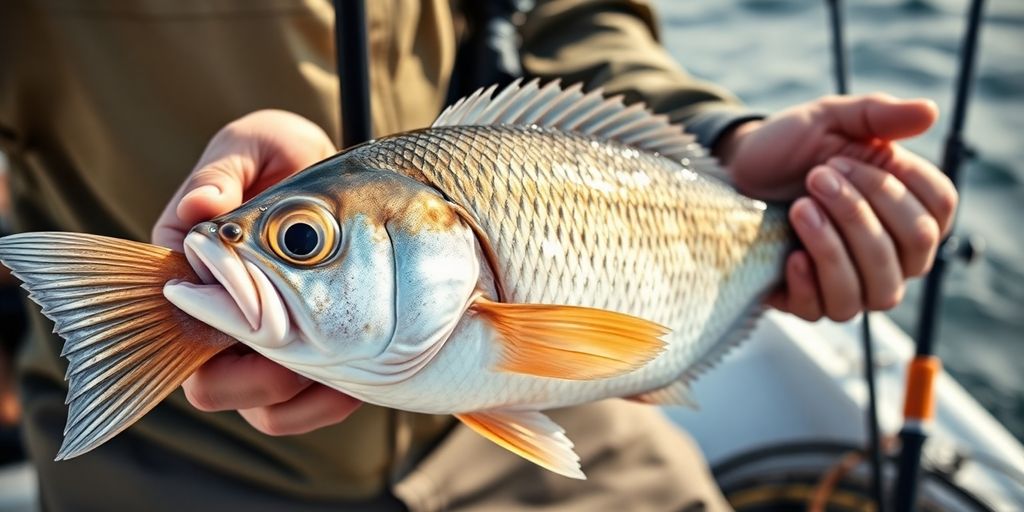
Bottom Fishing Techniques
Bottom fishing is a go-to method for porgy anglers. Using a medium to light rod with a sensitive tip helps detect those subtle bites. Aim to drop your baited rig near rocky structures, reefs, or wrecks where porgies love to hang out. Keep your line tight and be ready to set the hook as soon as you feel a nibble.
Here’s a quick checklist for bottom fishing:
- Use clams, squid, or small fish pieces as bait.
- Opt for a two-hook rig with small hooks (sizes 4 to 6).
- Adjust sinker weight based on water depth and current.
Chumming and Attracting Porgies
Chumming with a chum pot can really up your porgy fishing game. Ground clams or clam juice work well to lure these fish. Make a chum slick by dropping small amounts into the water now and then. Combine this with drift fishing, letting your boat move over promising spots while keeping bait near the bottom. Always anchor up-current from your target area to let the chum drift naturally towards where the fish are.
Jigging Techniques for Porgy
Jigging is super effective, especially in deeper waters. Small metal jigs or bucktail jigs in the 1/4 to 1 oz range are ideal. Tipping the jig with a bit of clam or squid adds extra attraction. Use a high-low rig or dropper loop rig to present multiple baits at different depths. Go for a slow, vertical jigging motion, lifting the rod tip about 6-12 inches, then letting the jig fall back. Porgies often strike as the jig descends, so keep an eye on any line movement.
Mastering these techniques can significantly boost your porgy catch rate, making each fishing trip more rewarding.
Fishing for Porgy in Different Waters
Inshore vs. Offshore Porgy Fishing
Fishing for porgy can be a rewarding experience whether you’re casting your line inshore or venturing offshore. Each environment offers its own unique set of challenges and rewards.
Inshore porgy fishing is often the go-to for beginners and those looking for a quick trip. You don’t need to travel far from the coastline, which means less time on the boat and more time fishing. Inshore waters are generally calmer, making them ideal for smaller boats and even kayaks. Here, you’ll find porgies hanging around rocky areas, piers, and jetties. The tackle needed is usually lighter, and the fish are slightly smaller, but they can still put up a fun fight.
On the other hand, offshore fishing for porgy takes you into deeper waters where larger schools and bigger fish await. This is where the adventure kicks up a notch. You’ll need a sturdier boat and heavier tackle to handle the deeper currents and the potential for larger catches. Offshore fishing often involves longer trips, but the payoff can be substantial with larger porgies and the chance to catch other species.
Exploring both inshore and offshore fishing can enrich your porgy fishing experience. Each offers a different perspective on fishing, from the serene and calm inshore waters to the exciting and unpredictable offshore adventures.
When choosing between inshore and offshore fishing, consider factors like the time you have, the equipment available, and your comfort level on the water. Both environments can be equally rewarding, depending on what you’re looking for in your fishing adventure.
Handling Bycatch: Sea Bass and Other Species
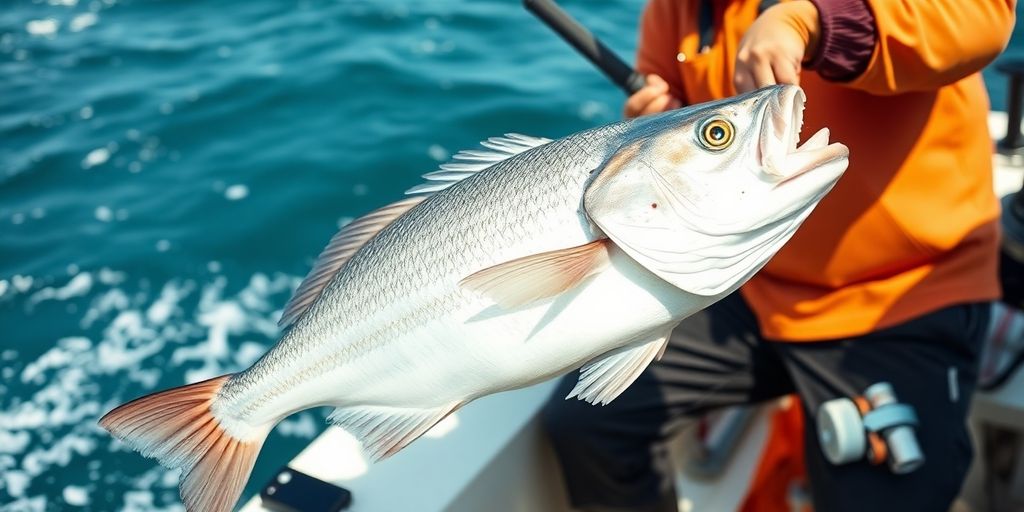
Identifying Common Bycatch Species
When you’re out fishing for porgy, it’s common to encounter other species that might not be your target. Sea bass is one of the most frequent bycatch species, often found in similar habitats as porgies. Recognizing them can be crucial to ensure you’re following local regulations and preserving healthy fish populations.
- Sea Bass: Typically found in rocky bottoms and reefs, they have a distinctive dark color with light spots and a notable hump on their heads.
- Fluke: These flatfish are often caught when fishing for porgies, particularly in sandy areas.
- Tautog: Known for their strong teeth and preference for rocky areas, these fish are also frequent bycatch when targeting porgy.
Handling bycatch responsibly is not just about following the law; it’s about maintaining the balance in our marine ecosystems. Always check local regulations for size and bag limits.
By understanding and identifying these common bycatch species, you can make informed decisions on how to handle them, whether you’re releasing them back into the water or keeping them if regulations permit.
Porgy Fishing Tips and Tricks
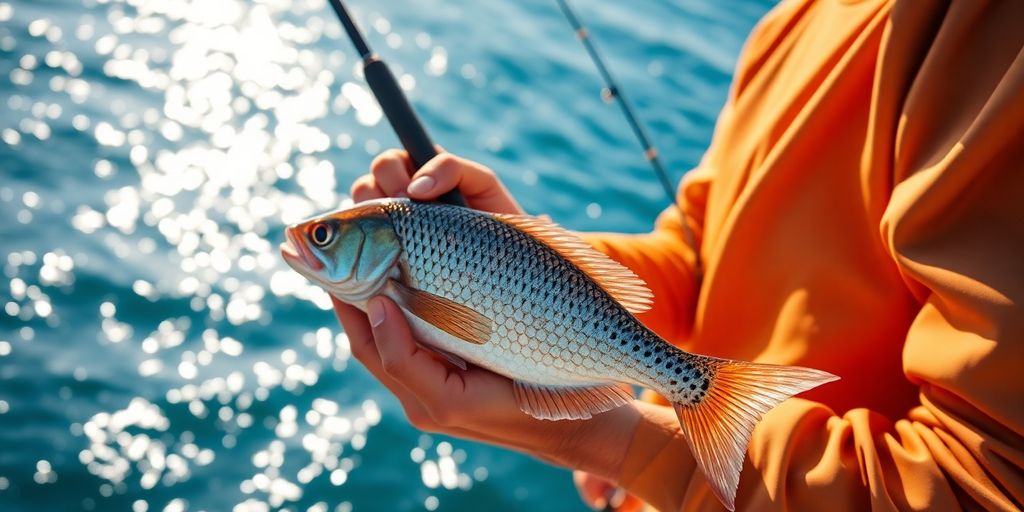
Best Times to Fish for Porgy
Catching porgy can be a real treat if you know when to hit the water. Timing is everything when it comes to fishing, and porgy is no exception. These fish are most active during tidal changes, especially when the tide is coming in or going out. This is when they tend to feed more aggressively, giving you a better chance to snag a few.
- Early Morning or Late Afternoon: These times are typically cooler, and porgies tend to be more active. Plus, the lighting conditions can make it easier to spot them.
- Tidal Changes: Fish during high tide or when the tide is rising or falling. The movement of water stirs up food and attracts porgies.
- Seasonal Considerations: Spring and early summer are generally prime times for porgy fishing, as they move closer to shore to spawn.
Keep an eye on the weather forecast and tidal charts before planning your fishing trip. A bit of preparation can make all the difference.
Additional Tips for Successful Porgy Fishing
Most anglers find that experimenting with different baits and staying mobile can significantly improve their catch rates.
Experiment with Baits: Porgies have small mouths, so using smaller baits like clam strips, squid, or sandworms can be more effective.
Stay Mobile: If you’re not getting bites, don’t hesitate to move around. Porgies can be found in schools, so finding the right spot is key.
Use Light Tackle: A light rod and reel setup will help you feel the subtle bites of porgies and improve your hook-up rate.
By following these tips and paying attention to the conditions, you’ll increase your chances of a successful day on the water. Enjoy the thrill of catching porgy and the delicious meals that follow!
Wrapping It Up: Your Porgy Fishing Adventure Awaits
So there you have it, folks. Porgy fishing isn’t just about the catch; it’s about the whole experience. From picking the right gear to mastering those techniques, every part of the process adds to the thrill. Whether you’re a newbie or a seasoned angler, there’s always something new to learn and enjoy. Remember, the key is patience and a bit of practice. So grab your gear, head to your favorite spot, and enjoy the peacefulness of the water. Who knows, you might just reel in the biggest porgy of your life. Happy fishing!
Frequently Asked Questions
What gear do I need for porgy fishing?
To fish for porgy, you’ll need a light to medium-light rod, a spinning reel, and small hooks. Pair these with bait like clams or squid for the best results.
How can I attract porgies while fishing?
Chumming is a great way to attract porgies. Use clam chum to create a scent trail in the water, drawing multiple fish to your area.
What is the best time to fish for porgy?
Porgies are most active during daylight hours, especially early in the morning and late in the afternoon. Fishing during incoming tides can also be more successful.
Why are dropper loops used in porgy fishing?
Dropper loops let you present multiple baits at different depths, making them effective for catching porgies that swim close to the bottom.
However, be prepared for the challenge of unhooking multiple fish if you have a successful catch.
What types of bait work well for porgy fishing?
Natural baits like clams, squid, and sandworms are effective for porgy fishing. You can also try small artificial lures like jigs.
How can I avoid bycatch when fishing for porgy?
Using the right hook size and bait can help minimize bycatch. Circle hooks are a good choice as they often hook fish in the mouth, making it easier to release unwanted catches.



